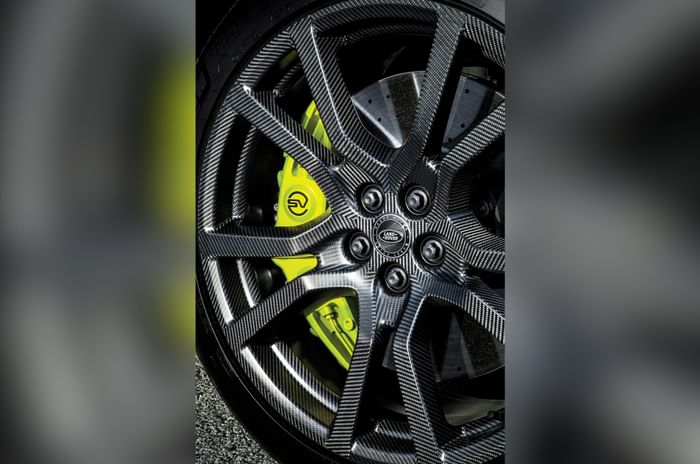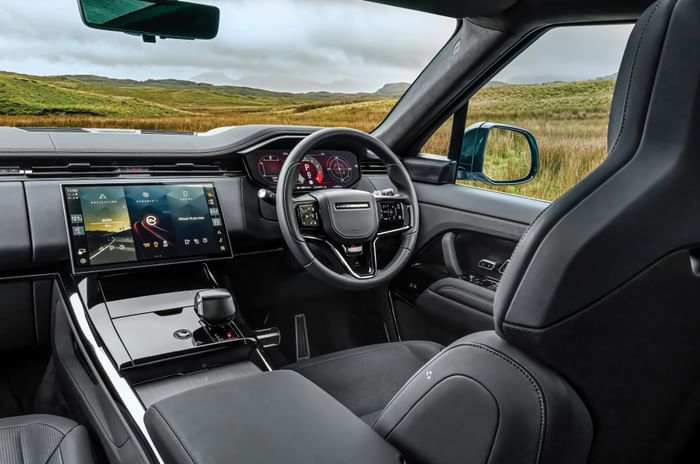What’s the fastest ever Range Rover like? We spent a day with it in the UK and came away very impressed.
Don’t let the ‘Sport’ in its name mislead you; what makes this Range Rover quick is the little SV badge instead, though that also needs some clarification. You see, per JLR, SV cars in the JLR-verse are the ‘exquisite interpretations by Special Vehicle Operations’. So, while on the Range Rover, SV denotes ‘even more luxury’, on the Range Rover Sport, it signals ‘the fastest Range Rover of all time’.
SV on the Range Rover Sport signals the fastest Range Rover of all time.
Indeed, powered by JLR’s BMW-sourced 4.4-litre twin-turbo petrol V8, tuned here to 635hp, this Range Rover Sport SV does the 0 to 100kph dash in a claimed 3.8 seconds and tops out at an impressive 290kph. So, while it’s got some off-road chops, it’s quite a different take from its regular off-roading siblings, and we got a day to experience it in the UK.
Range Rover Sport SV Performance and Refinement: 8/10
The breadth of the powertrain’s character transformation is impressive
Engage SV mode via the illuminated button positioned towards the base of the steering wheel, and the Sport SV preps the entire car, chassis, engine and all for a performance level beyond the regular Dynamic mode. Ride height drops by another 15mm, and torque bumps up 50Nm to 800Nm with the Dynamic launch mode.
| Range Rover Sport SV specs | |
|---|---|
| Engine | Mild-hybrid, twin-turbo V8 |
| Displacement | 4395cc |
| Power | 635hp |
| Torque | 750Nm (800Nm with dynamic launch mode) |
| Gearbox | 8-speed AT |
| Drive layout | All-wheel drive |
| 0-100kph (claimed) | 3.8 seconds |
| Top-speed (claimed) | 290kph |
And boy, it is quick. I floor it in manual mode first and hit the redline in first and second gears before I can tug at the paddle. Cog swaps need to be supercar-style quick, and after telling my brain that, I get the full-bore launch – what a rush that is. Power delivery is thick and fast, and it revs freely past 7,000rpm; the acceleration feels nice and raw with sharp and quick gearshifts, quite uncharacteristically for a planetary torque converter autobox and quite a transformation from the unit’s daily driver abilities that it does just fine, too.

Sport SV’s straight-line speed and the engine’s flexible character are a delight.
What’s nice is there’s a neat soundtrack as well; perhaps some of the engine note is piped in through the speakers. But I’m not complaining; the gurgle from the exhausts is something we may soon not hear at all. Dynamic mode dials things down from wild to energetic. And left in Auto mode, the Sport SV is quite the relaxed town cruiser.
Range Rover Sport SV Ride Comfort and Handling: 7/10
Can hold its own around corners but isn’t what you could call agile
With all that propulsion, keeping a two-and-a-half-tonne SUV on the road is tricky business, so JLR has thrown a lot in terms of chassis systems. There’s all-wheel drive, all-wheel steering, torque vectoring by braking, an active rear locking differential and a setup that the company calls 6D Dynamics, a system that combines hydraulically linked dampers and height-adjustable air springs.
Not light on its feet but hydraulically linked dampers help keep things sane around corners.
The semi-active 6D system does away with the need for anti-roll bars, and instead, the hydraulically linked dampers pump fluid between each other to keep roll and pitch in check. It does work to an extent; cornering around some twisty British B and C roads, the Sport SV feels composed, but it’s never agile or light on its feet like a Porsche Cayenne, for instance. Ride quality is firm, and you can easily feel every rut and crack from the road surface. Move out of SV mode, and things improve, but even at its most plush setting, there is a sharp edge to the ride.

23-inch carbon-fibre wheels look neat but lend a firm edge to ride quality.
No doubt the 23-inch carbon fibre rims with the slim Michelin Pilot Sport All Season tyres do no favours. The steering weight is fine and changes with the drive mode, but it lacks an incisive feel to it. Braking performance is just fine, and the optional carbon-ceramic disc did a good job hauling this massive brute down from high speeds.
Range Rover Sport SV Mileage: 6/10
The combined WLTP fuel efficiency rating for the Sport SV is 8kpl
It might have mild hybrid tech, but with its weight and performance tuning, don’t expect the SV’s kilometre per litre figure to be in two digits. The official WLTP rating for the Range Rover Sport SV’s fuel efficiency is 8kpl.
Range Rover Sport SV Exterior Design and Engineering: 8/10
The SV does not shout sport in your face but has enough presence to draw attention
| Range Rover Sport SV dimensions | |
|---|---|
| Length | 4970mm |
| Width | 2209mm |
| Height | 1814mm |
| Wheelbase | 2998mm |
| Kerb weight | 2560kg |
| Tyres (F, R) | 285/40 R23, 305/35 R23 |
Now in its third generation, the Sport moves to a new platform: JLR’s MLA-Flex, which gives it multiple powertrain options, including full electric due later. The exterior, though, features familiar styling cues as its predecessor; it’s just a bit sleeker and meaner – for instance, the grille, the headlights and the glasshouse area are slimmer, giving the car a sportier look.

SV variant gets a healthy splash of carbon fibre trim all around.
The SV version, which is dialled up further, has broader air intakes at the bumper’s edges, reprofiled lower sides and functional quad-exit tailpipes. And, of course, there’s plenty of carbon fibre: from the aforementioned 23-inch rims to trim bits around the tailpipes, as well as for the front bumper slats, grille, and hood and side vents. There’s also the option of a carbon-fibre hood. Then there are vivid colours for the body and brake calipers, too, that you can also spec. All in all, to these eyes at least, the SV does the sport look just right, not too much but not too little either.
Range Rover Sport SV Space and Comfort: 7/10
Spacious insides are more luxurious than outright sporty
The insides look luxurious with a minimalistic styling theme, though it’s almost to the point of being quite bland, especially so for those who like things blinged-up. The dashboard is presented as a large, clean surface upon which a 13.1-inch touchscreen is placed. The central console, too, has its cubbies closed off and just a small stubby gear lever sticking out. Being the SV, there are some sporty bits like illuminated SV logos on the backrests and edge-illuminated paddle shifters, but on the whole, the interior does not scream sport.

The cabin is classy, but some will find the minimalistic style bland.
The SV also debuts JLR’s new ‘body and soul seats’ (BASS), which, as the acronym suggests, generate audio vibrations corresponding to the media played on the 29-speaker Meridian sound system. Available on the front seats only, there are also six different soundscapes – designed in collaboration with the National Transport Design Centre at Coventry University and the School of Media and Performing Arts – that combine sound and vibrations to relax or energise you. It’s hard to accurately describe the feeling, but it’s somewhere between a massage and a vibrating seat. Speaking of the seats, I found the lumbar a touch extra, but seating space both at the front and rear is ample enough.
Range Rover Sport SV Features and Safety: 8/10
The Sport SV Edition Two trim comes well equipped
The car we had in the UK was the ‘Edition Two’ spec, which meant it was well-equipped with bits like digital LED headlights, illuminated metal treadplates, 4-zone climate control, a 13.1-inch touchscreen, Meridian signature sound, 3D surround cameras, remote park assist, HUD, and heated ventilated and reclining seats at the front and rear. As for safety equipment, it has six airbags and a full ADAS suite, which works just fine on UK roads.
Range Rover Sport SV Price and Verdict: 8/10
The Sport SV is certainly the most capable all-rounder in the JLR fleet
Super SUVs of today are remarkable feats of engineering that have to deliver on diverse fronts: they have to be large and spacious like family SUVs, comfy like luxury sedans and quick like sports cars. So, they come at a price; in this one’s case, that’s Rs 2.95 crore ex-showroom, India. It’s a lot, but no more – in fact, exactly the same – as the Audi RS Q8 Performance, and in that aspect, it’s a fair ask.
It’s the Sport SV’s breadth of talents that is truly impressive.
It’s wanting in some places for sure. Like around corners, it’s not very agile, and ride quality, too, is not as pliant as some rivals. But while it cedes ground on dynamics, it gains in many areas. The interior, for example, is spacious and comfy, with a luxurious and classy feel. Outside, the styling is sleek and sporty, with a nice, elegant flair to it, and then, given its family lineage, the Range Rover Sport SV also has some off-roading chops baked into its DNA – 23-inch rims notwithstanding – and, in the end, that’s where its appeal lies. It’s the most capable all-rounder in the JLR portfolio and, against rivals, has a truly wide set of talents.
Also See:
2025 Audi RS Q8 Performance review: a practical supercar for India
Maserati Grecale review: India friendly Maserati